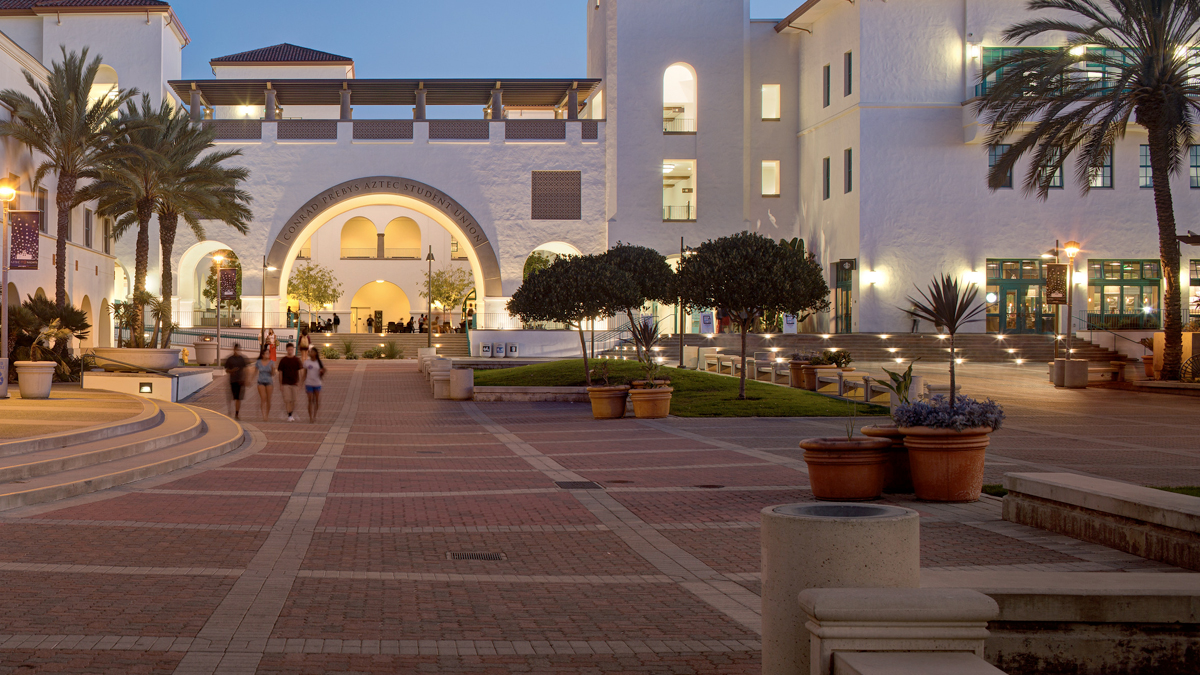Super Bowl Q&A with Sports MBA Program Director, Scott Minto

Scott Minto, Sports MBA Program Director
COVID-19 has had a significant impact on the sports and entertainment industry. Professional sports leagues and event organizers have had to make several pivots to coordinate regular season games and championship competitions that abide by pandemic restrictions.
The current impact of pandemic will be on display during what is historically the most watched sporting event of the year - the Super Bowl. This year’s big game will be played at Raymond James Stadium in Tampa, Florida on February 7, 2021.
While the NFL has stated that they are “committed to delivering the ultimate fan experience in the safest way possible” this year, the in-stadium and at home experience is expected to be different.
Scott Minto, director of the Sports MBA program at San Diego State University, shares his thoughts on the pandemic’s impact on the big game, including reduced capacity, ticket sales,TV ratings and the presence of the home team playing in the Super Bowl, as well as the lasting impact of COVID-19 on the sports industry.
Q: What type of impact has COVID-19 had on the NFL this past year and how will Super Bowl LV be different than previous Super Bowls? What are some of the differences fans will see on TV in Tampa this year?
COVID-19 significantly affected NFL revenues, with estimates in the $100s of millions per team and $3-$4 billion for the league as a whole. Despite being impacted by COVID-19-related opt-outs, absences, and pauses in activity, the games continued on schedule and the league will stage the Super Bowl on time.
Though only a small number of fans, ranging from 10%-20% of capacity, were allowed in most of the NFL’s venues this season, television viewers saw a familiar product on the field. Without fans, however, home-field advantage nearly evaporated this season, with home teams winning below .500 for the first time in NFL history with a record of 127-128-1
In Tampa, fans will see socially-distanced 25,000 fans inside Raymond James Stadium along with 30,000 cardboard cutouts, which have become a familiar aspect of COVID-19 sporting events. 7,500 of the 25,000 fans in attendance will be vaccinated health care workers from around the country who will receive free tickets from the NFL, so fans can expect a number of on-field salutes and homages to these front-line workers in the pregame shows and during the broadcast.
Q: The stadium will be around ⅓ full due to the pandemic. What impact does reduced capacity have on ticket prices and sales?
For die-hard fans, attending the Super Bowl is a dream that’s become increasingly more difficult to attain in recent years as hospitality and corporate client tickets have taken over the supply.
30 NFL teams each get 1% of the ticket inventory to allocate, the host team 5%, the participants split 35%, and the NFL holds the remainder of inventory.
This year, as of February 3, the get-in price is in the $5,000 range, but inventory is low due to the limited stadium capacity.
With so few parties and ancillary events in Tampa this week due to the pandemic, many casual fans may decide to sit this year out, perhaps freeing up inventory for purchase by either die-hard Chiefs or Buccaneers fans who may have been priced out by corporate guests in previous years.
Q: According to Nielsen, the 2020 NFL regular season ratings saw a 7% decline from previous regular seasons seeing its lowest audience since 2017. With the state by state pandemic restrictions resulting in fewer Super Bowl gatherings, what will be the impact on the “Big Game”?
Ratings for all sports have been down this year, even for marquee events. The 2020 World Series was down 32% and the postponed Masters tournament was down nearly 50% from the previous year.
Super Bowl LV ratings likely will be the result of give-and-take between two major factors. First, there’s the idea that ratings could be down due to the general upheaval that the pandemic has imposed on all of our lives, which has upended our routines, closed schools and daycares, forced us to cook more, and generally turned things on end. On the other hand, ratings could be *up* for this year’s Super Bowl LV given the fact that it’s always the biggest television night of the year, and this particular year there are far fewer options for other things to do on a Sunday night in February when a lot of major media markets have a foot of snow on the ground.
Aside from television ratings, another measurement of the Super Bowl’s popularity is the wagering that takes place on the game’s outcome and various prop bets. The American Gaming Association is predicting a decrease in wagers on this year’s Super Bowl due to the lack of access to in-person sportsbooks, even though online sports betting has now been legalized in 6 states and D.C. since last year’s Super Bowl.
With many typical office positions still remote, traditional office pools will take a hit, but I expect virtual pools to fill a good amount of that void. As we’ve adjusted to shifting so much of our lives online, I see Zoom Super Bowl watch parties and Excel-sheet square pools with coworkers, family, and friends entering into our lives this year, particularly with the ease of transferring money with apps such as Venmo.
Q: Several Super Bowl advertising regulars like Anheuser-Busch, Coca-Cola, and PepsiCo have opted-out of SuperBowl LV ads. What do you attribute this to and how does it impact the commercial space for this year’s event?
A lot of these perennial Super Bowl advertisers are likely sitting this one out due to uncertainty involved in striking the right tone with this year’s game being played amidst a pandemic that’s taken the lives of close to (as of this writing) a half-million Americans. Beyond that, the game is just a month removed from a deadly assault on the U.S. Capitol and the NFL was front and center in the conversation of racial inequality after Colin Kaepernick essentially lost his job in the league after peacefully protesting by kneeling for the national anthem in 2016. These realities present a number of ways an ad can be poorly received by viewers, causing immediate social media backlash for the brands involved.
Pepsi will take a more straightforward approach, running ads stating weeks ahead of time promoting the Pepsi Halftime Show entertainer, The Weeknd. It’s likely that Pepsi learned their lesson after airing a disastrously tone-deaf Kendal Jenner ad in 2017, and is sidestepping the chance to strike the wrong tone with a 30-second commercial.
Q: Super Bowls typically bring millions of dollars in economic impact into host cities. In this unprecedented year, what will the economic impact of Super Bowl LV look like in Tampa Bay?
The short answer is that the overall economic impact will be significantly lower than in a typical year. Without a doubt, COVID-19’s will be the major culprit for the overall decrease in impact. The reduced capacity in the stadium is a factor, but the cancellation of all of the ancillary Super Bowl week parties and hospitality will hurt much more. The typical number of visitors to a city for Super Bowl week far outnumbers the number of ticketed fans, players, and team staff. The impact comes, in large part, from the fans, celebrities, or businesspeople who flock to town for the parties who have no plans to attend the game. Beyond that, there are thousands of support staff, who often spend weeks in town preparing for marquee events like fan zones, galas, and parties. There’s also an enormous support staff working at brand activations and parties, plus volunteers who all contribute to the overall economic impact. That’s a lot of hotel room nights and restaurant meals that Tampa won’t have for this year’s event.
The presence of the home team playing in the Super Bowl for the first time in NFL history will further dampen the impact of Super Bowl LV. Economic impact studies measure the amount of money that enters into an economic area (typically at the county level) and the levels of indirect and induced spending brought to bear by that injection of outside funds. In assessing the impact of Super Bowl LV, money spent by residents of Tampa Bay will typically be excluded, as it’s not new money being introduced into the economic area and is considered a displacement of funds that local residents could have spent on other forms of entertainment, buying a new boat, building an addition on their house, etc.
Q: Do you see any lasting impacts of COVID-19 on the sports/entertainment industry?
I’m hearing from sports and entertainment executives that sports will bounce back in a major way once things start to return to normal. Fans really miss live events, and once things go back to normal, the appetite for in-person entertainment is likely to be substantially higher than it was pre-pandemic.
That appetite, as we’ve seen with ratings and social media traction during the past year, will most certainly include women’s sports, as new--and loyal-- fans have been flocking to domestic leagues like the WNBA, NWSL, and NWHL.
Many of the innovations that sports organizations have had to implement, particularly in the areas of fan engagement, are likely here to stay. The personalization of the experience for fans who can’t be in the arena has tremendous potential moving forward.
Q: What advice would you give to students looking to enter into the sports industry during these uncertain times?
The good news is, the jobs the industry lost will come back, and the industry will continue to grow once fans are back at capacity. New roles stemming from recent innovations will be in high demand, along with a number of positions in analytics, the eCommerce industry, and more areas of sports, esports, entertainment, and apparel that have seen growth during COVID-19.
Networking has long been a requirement within the competitive sports industry and historically something only done face-to-face in an office or conference setting. Many networking activities that were forced online will stick around to some degree, so we’ll continue to see online components of historically in-person conferences, Zoom informational interviews and job interviews, and a continuation of online panels well beyond the end of the pandemic.
Lastly, I’d be remiss if I didn’t point out that now is a great time to head back to grad school to build your skills and your network with an eye on entering the sports industry when it’s once again fully operational. SDSU Sports MBA is currently accepting applications through March 1st for our August 2021 on-campus start.

